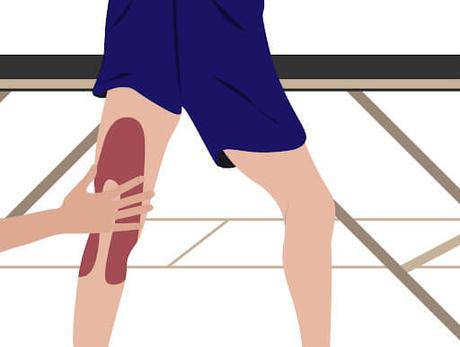Hamstring tendinosis is a condition that causes pain and inflammation in the hamstring tendons. The hamstring tendons are the tough bands of tissue that attach the hamstring muscles to the bones in the back of the thigh.
Hamstring tendinosis is a degenerative condition, meaning that it is a condition that causes the tissue to break down over time. This can be caused by a number of factors, including:
- Overuse: Hamstring tendinosis is often seen in athletes who participate in activities that require a lot of running, jumping, or kicking.
- Improper biomechanics: If you have poor running or jumping mechanics, you may be more likely to develop hamstring tendinosis.
- Injuries: A previous hamstring injury can increase your risk of developing tendinosis.
The symptoms of hamstring tendinosis can vary from person to person. However, some common symptoms include:
- Pain: The pain is usually located in the back of the thigh, near the ischial tuberosity (the bony prominence at the top of the hamstring muscles).
- Stiffness: The hamstring muscles may feel stiff, especially after sitting for a long time.
- Weakness: You may feel weak in the hamstring muscles, making it difficult to do activities such as running or climbing stairs.
What Is KT Tape?
KT taping is a type of kinesiology tape that is used to help improve muscle function and reduce pain. It is made of a thin, elastic fabric that is covered with an adhesive. The tape is applied to the skin in a way that lifts the skin slightly, which helps to reduce inflammation and improve circulation.
KT taping is often used to treat a variety of injuries and conditions, including:
- Muscle strains and sprains
- Tendonitis
- Joint pain
- Swelling
- Scar tissue
- Post-surgical recovery
KT taping is also used to improve athletic performance and prevent injuries. There exists over 600 research articles outlining the evidence for KT taping (~80% published in the last 5 years) but there is no clear evidence that it helps all the above claims and uses of KT taping.
There are three main types of KT taping:
- I-strip: This is the most basic type of KT taping and is used to provide support and stability to a muscle or joint. The tape is applied in a straight line and can be used to either restrict or facilitate movement.
- X-strip: This type of KT taping is used to provide more support and stability than an I-strip. The tape is applied in an X-shape and can be used to cross multiple joints or muscles.
- Y-strip: This type of KT taping is used to provide support and stability to a muscle or joint that is located in a curved area. The tape is applied in a Y-shape and can be used to help improve range of motion.
In addition to these three main types, there are also a number of other variations of KT taping that can be used for specific purposes. For example, there are tapes that are designed to help reduce pain, improve circulation, or prevent injuries.
The type of KT taping that is used will depend on the specific injury or condition that is being treated. A physical therapist or other healthcare professionals can help you determine which type of KT taping is right for you.
Here is a table that summarizes the different types of KT taping:
Type of KT tapingDescriptionPurpose
I-stripA straight line of tapeProvides support and stability
X-stripAn X-shaped piece of tapeProvides more support and stability
Y-stripA Y-shaped piece of tapeProvides support and stability to a curved area
Pain-relieving tapeContains a pain-relieving medication in the adhesiveHelps to reduce pain
Circulation-improving tapeContains a substance that helps to improve circulationHelps to improve circulation
Injury-preventing tapeContains a substance that helps to prevent injuriesHelps to prevent injuries
Here some other uses for shoulders and wrists: KT Tape Shoulder and KT Tape Wrist.
How Does KT Tape Help Relieve Hamstring Tendonitis?
The first question is, how does KT taping work for musculoskeletal issues? The tape reduces pain and increases sensitivity by increasing lymphatic drainage and blood flow in the subcutaneous tissue.
Blocks the pain signals according to the gate control theory by increasing the stimulations to the afferent nervous system. It also has effects in the form of muscle stimulation or inhibition depending on the technique of the application.
Does KT Tape Hamstring Tendonitis Really Work?

Unfortunately, when reviewing the literature from the National Library of Medicine, there are no studies on the outcomes for hamstring tendinosis and the use of KT taping. There are several studies that showed KT taping can improve the flexibility and activation of the hamstring tendon, but nothing on symptomatic hamstring tendinosis.
While there are no current studies showing the effectiveness, KT taping is a modality that may assist in your physical therapy to strengthen the area to allow more rigorous therapy. Because KT taping is very benign and low risk, it is a good option to see if there are any benefits from it.
Risks Of Using KT Tape Hamstring Tendonitis
KT taping is generally safe and effective, but there are some potential side effects and complications that can occur. These include:
- Skin irritation: The adhesive on the tape can irritate the skin, especially if it is left on for too long.
- Allergic reactions: Some people may have an allergic reaction to the adhesive on the tape. This can cause symptoms such as itching, redness, and swelling.
- The tape may come loose or fall off: If the tape is not applied correctly, it may come loose or fall off. This can be a problem if the tape is being used to provide support or stability.
- The tape may restrict movement: If the tape is applied too tightly, it can restrict movement. This can be a problem if the tape is being used to improve range of motion.
There are some contra-indications for KT taping. These include:
- Open wounds: KT taping should not be applied over open wounds.
- Skin conditions: KT taping should not be applied over skin conditions such as eczema or psoriasis.
- Allergic reactions: If you have a history of allergic reactions to adhesives, you should not use KT taping.
- Circulatory problems: KT taping should not be applied over areas of the body with poor circulation.
- Deep vein thrombosis (DVT): KT taping should not be applied over areas of the body with DVT.
- Malignancy: KT taping should not be applied over areas of the body with malignancy.
If you have any of these conditions, you should not use KT taping without first consulting with your doctor or physical therapist.
Here are some other things to keep in mind about KT taping:
- KT taping should not be used as a substitute for medical care. If you are experiencing pain or other symptoms, you should see a doctor or physical therapist for diagnosis and treatment.
- KT taping should not be used to treat serious injuries. If you have a serious injury, you should seek medical attention immediately.
- KT taping should not be used for more than 2-3 days at a time. After 2-3 days, the tape can start to irritate the skin.
- KT taping should be removed if it becomes loose or falls off. A loose or falling tape can restrict movement or cause skin irritation.
Is There A Better Option?
Literature exists for PRP and tendinosis, and especially hamstring tendinosis. This literature proves that about 70% of patients can benefit from PRP injections into their tendinopathic hamstring tendons and that PRP injections result in both reduction of pain and functional improvement!
Alternative Treatment For Hamstring Tendonitis
While KT taping is a good option to possibly assist in the rehabilitation process of hamstring tendinosis, it should not be used as solo treatment. Rather, KT taping should be regarded as an adjunct therapy to assist PT.
If you continue to experience pain and want to explore better options, connect with our team to set up an evaluation and see if you are a candidate for PRP or other ortho-biologics. Our goal is to help get you back on the field, in the gym, on the road, or wherever else you want to go!
Get our personalized treatment plan and advanced techniques with Dr. Markle. Schedule an appointment today!
Click HereReferences:
- Roberts S., Ramklass S., Joubert R. Kinesio Taping® of the metacarpophalangeal joints and its effect on pain and hand function in individuals with rheumatoid arthritis. S. Afr. J. Physiother. 2016;72:9. doi: 10.4102/sajp.v72i1.314. [PMC free article] [PubMed] [CrossRef] [Google Scholar]
- Kun L., Lulu Y., Zheng M., Bo Y., Yanhong M., Lihua H. Effect of Different Kinesio Taping Interventions on the Local Thresholds of Current Perception and Pressure Pain in Healthy Adults. Front. Physiol. 2020;11:596159. [PMC free article] [PubMed] [Google Scholar]
- Chen CH, Huang TS, Chai HM, Jan MH, Lin JJ. Two stretching treatments for the hamstrings: proprioceptive neuromuscular facilitation versus kinesio taping. J Sport Rehabil. 2013 Feb;22(1):59-66. doi: 10.1123/jsr.22.1.59. Epub 2012 Oct 11. PMID: 23069636.
- Adhitya IPGS, Yu WY, Bass P, Kinandana GP, Lin MR. Effects of Kinesio Taping and Transcutaneous Electrical Nerve Stimulation Combined With Active Stretching on Hamstring Flexibility. J Strength Cond Res. 2022 Nov 1;36(11):3087-3092. doi: 10.1519/JSC.0000000000004088. Epub 2021 Jun 30. PMID: 34224508.
- Ozmen T, Yagmur Gunes G, Dogan H, Ucar I, Willems M. The effect of kinesio taping versus stretching techniques on muscle soreness, and flexibility during recovery from nordic hamstring exercise. J Bodyw Mov Ther. 2017 Jan;21(1):41-47. doi: 10.1016/j.jbmt.2016.04.001. Epub 2016 Apr 14. PMID: 28167188.
- Auriemma MJ, Tenforde AS, Harris A, McInnis KC. Platelet-rich plasma for treatment of chronic proximal hamstring tendinopathy. Regen Med. 2020 Apr;15(4):1509-1518. doi: 10.2217/rme-2019-0105. Epub 2020 May 18. PMID: 32419631.

